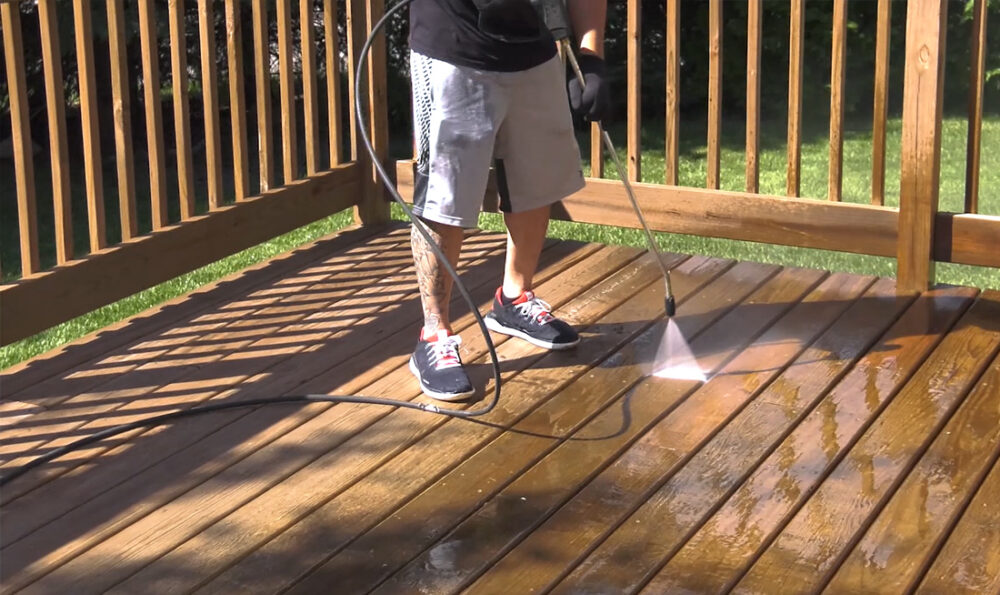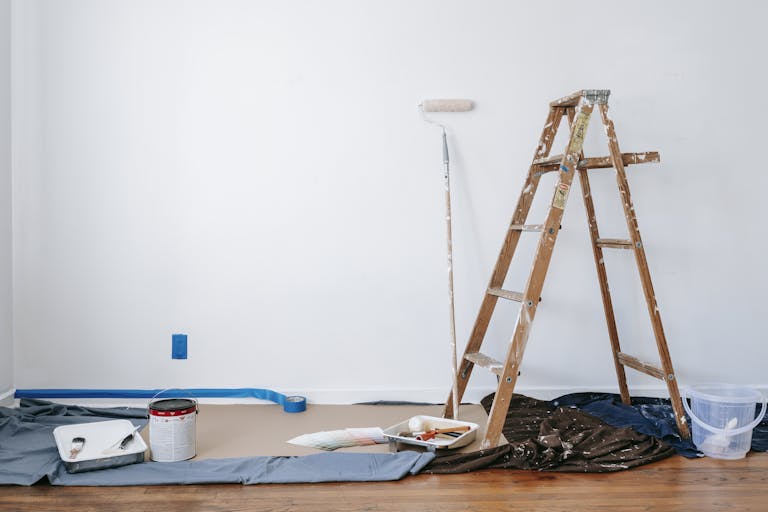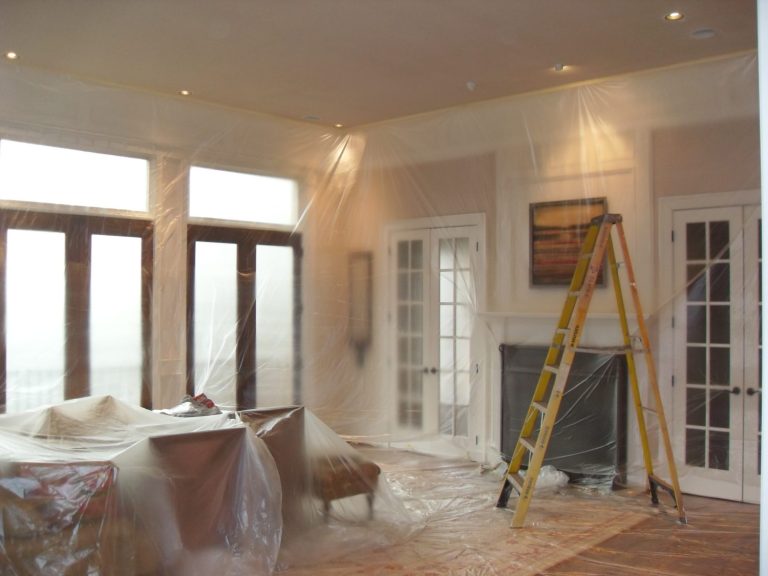Can You Use A Paint Sprayer For Stain
Making your woodworking projects stand out by making them look their best is an excellent way to ensure their durability. Stain is necessary for almost any project’s finish, but it can be challenging to apply correctly and evenly. Most woodworkers apply stain with a brush or rag, but have you ever considered using a paint sprayer instead? In this article, we’ll talk about whether or not you should try staining projects with a paint sprayer. We’ll also review some pointers and tricks for getting the best results from this precision tool crafting method. So, if you’re thinking about jumping, keep reading!

Benefits of Using a Paint Sprayer for Stain:
A paint sprayer can be invaluable for staining outdoor furniture, decking, and other surfaces. While a brush is a traditional method of applying stain, using a paint sprayer can save time and allow for more even coverage. Here are some advantages of using a paint sprayer for stains:
Speed & Efficiency:
With a paint sprayer, you can cover large areas much faster than with a brush or roller, especially if you’re working on multiple furniture or decking planks. This means you’ll be able to complete your project in less time and with fewer strokes.
Greater Control:
The versatility of a paint sprayer allows you to control the amount and direction of the stain. This means you can apply thin layers and avoid areas that don’t need staining. It also makes it easier to get into corners or hard-to-reach places.
Event Coverage:
One of the most significant benefits of using a paint sprayer for stains is that it offers more even coverage than brushing or rolling on a stain unevenly. This ensures a nice, consistent finish without putting in too much effort.
Minimal Drips & Mess:
With a brush or roller, it’s easy for the stain to drip down onto surfaces below where you are working; this isn’t an issue with a sprayer. This means you won’t have to worry about making a mess or cleaning up after yourself.
Using a paint sprayer for stains is an efficient and effective way to get the job done quickly and easily. With its speed, control, even coverage, and minimal mess, it’s no wonder why so many people are choosing to use a paint sprayer for their staining needs.
Can You Use a Paint Sprayer to Spray Wood Stains?
Yes, you can stain wood with a paint sprayer. Before spraying the wood with a paint sprayer, some steps should be taken for the best results and safety.
Wear a Respirator:
A respirator is essential for protecting yourself from fumes, dust, and other particles that can be released when spraying your wood stain. Be sure to wear one every time you spray.
Clean the Sprayer:
Before spraying, clean the paint sprayer of any leftover paint or residue. Run water through it until it comes out clear before beginning staining with a paint sprayer.
Create a Backdrop:
If you can’t access a Paint Booth, create a backdrop to help contain over-spray. Cover floors and walls that won’t be stained with tarps or plastic sheeting, then tape them securely around the edges.
Ventilation:
Ensure that your paint area is well-ventilated. If you don’t have good ventilation, it’s best to go outside or in a garage with the door open.
Plan Your Spraying Routine:
It’s essential to plan how you will spray each piece of wood. Start with details furthest away first and work your way closer, ending with the closest area last. This helps ensure even coverage and prevent overlap from different sections.
Apply the Stain:
Follow the specific product instructions for your wood stain to apply it correctly with a paint sprayer. Move the sprayer in continuous, even strokes and use multiple passes when necessary.
These steps will ensure your wood’s safe and successful staining with a paint sprayer. Be sure to take all safety precautions when spraying any material or finish.
Tips for spraying stains with a paint sprayer:
- Choose a suitable paint sprayer. Make sure you select a model ideal for staining and won’t cause an uneven coating on your project.
- Prepare your surface. Clean off dust, dirt, and other residues from the surface of what you spray with a damp cloth before beginning to ensure even coverage.
- Dilute your stain as needed. Depending on the sprayer you are using, it might be necessary to dilute the stain to get the best results when spraying.
- Test first! Before starting your project, do a test run on a scrap piece of wood or other material to ensure the spray pattern and coverage are to your liking.
- Protect yourself. Wear safety goggles and a respirator mask while spraying to protect your eyes, lungs, and skin from any fumes or particles that may be released into the air.
- Put on protective clothing. Wear long sleeves and pants when staining – you don’t want splatters all over your nice clothes!
- Don’t oversaturate the surface with stain. Too much stain will cause an uneven finish, leading to unwanted runs or drips in your coating.
- Keep moving! As you spray the stain, move the nozzle quickly side-to-side in even strokes without lingering in one spot for too long. This will ensure even coverage and reduce the chances of creating a blotchy finish.
- Work in sections. Break up your surface into small sections and work on each one at a time before moving on to the next one to ensure even coverage and prevent overlap.
- Clean your sprayer promptly after use. If you let the stain dry inside the machine, it can clog and affect its performance over time, so clean your sprayer immediately when you’re done using it!
These tips can help you achieve professional-looking results when spraying the stain with your paint sprayer.
read more: How To Paint Apartment Walls In Dubai
Frequently Asked Questions:
Yes, you can use a paint sprayer to stain wood. However, it is not recommended as the finish may not be even and consistent, leaving visible streaks on the surface. It is also more challenging to control the amount of stain applied and can lead to an uneven application if not done carefully.
When staining wood, using an HVLP (High Volume, Low Pressure) or airless paint sprayer is best. This will ensure uniform coverage and better control over how much stain is applied. Read the manufacturer’s instructions to ensure proper setup and use.
Yes, it is recommended that you thin the stain with a compatible thinner before using a paint sprayer for staining wood. This will help apply an even coat and reduce the risk of clogging the sprayer nozzle.
When using a paint sprayer for staining wood, it is best to use a tip size between 1.5mm and 2.0mm. Smaller tips are unsuitable as they produce too fine of an atomized mist which could lead to runs or splatters on the surface. A larger tip may leave visible brush strokes in the finish due to its broader fan pattern.
Conclusion:
Finally, using a paint sprayer to apply stain is sometimes necessary, but it is not always needed. Although paint sprayers can apply stains to specific surfaces, the results may be disappointing. Paint and stains are incompatible and should not be used in the same application. In addition, improper sprayer operation can cause overspray and stain damage. As a result, most stains are applied using a brush or roller. It is critical always to follow the manufacturer’s instructions when using a paint sprayer for any application.






